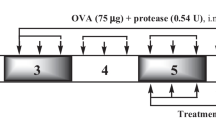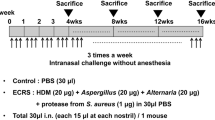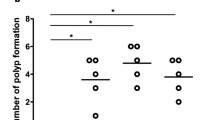Abstract
One subtype of chronic rhinosinusitis with nasal polyps (CRSwNP) is characterized by the development of a T-helper type 2 (Th2) response and eosinophilic infiltration. Here, we aimed to establish an eosinophilic CRSwNP murine model, which would be essential to understand the underlying pathogenesis and establish a treatment strategy. C57BL/6 mice were challenged intranasally with a mixture of an Aspergillus oryzae-derived protease (AP) and ovalbumin (OVA) for 6, 8, or 12 consecutive weeks (12 mice/group); control mice received the same volume of phosphate-buffered saline for 12 weeks (n = 12). Sinonasal samples were evaluated histologically, and interleukin (IL)-4, IL-5, IL-13, eotaxin, keratinocyte chemoattractant, and macrophage inflammatory protein-2 mRNA levels in sinonasal mucosa were measured by real-time PCR. Protein levels of Th2 cytokines, INF-γ, IL-17A, and chemokines in nasal lavage fluid, and total serum IgE were measured by ELISA. Greater eosinophil infiltration in the subepithelial layer was observed in the challenged groups, compared with the control group. Polypoid mucosal lesions were predominantly observed in the 12-week group, which also exhibited mucosal thickening on micro-CT scans. The IL-4, IL-5, and IL-13 mRNA and protein levels were elevated in the sinonasal mucosa and nasal lavage fluid. INF-γ and IL-17A were undetectable or not elevated relative to the control group levels. In contrast, eotaxin levels were particularly elevated in the sinonasal mucosa and nasal lavage fluid in the 12-week group. In conclusion, intranasal AP and OVA exposure successfully induced Th2-specific CRSwNP in a murine model.






Similar content being viewed by others
References
Chaaban MR, Walsh EM, Woodworth BA (2013) Epidemiology and differential diagnosis of nasal polyps. Am J Rhinol Allergy 27:473–478. doi:10.2500/ajra.2013.27.3981
McGarry G, Melia L (2009) Nasal polyps: an update. Br J Hosp Med (Lond) 70:500–504. doi:10.12968/hmed.2009.70.9.43865
Zhang N, Van Zele T, Perez-Novo C, Van Bruaene N, Holtappels G, DeRuyck N, Van Cauwenberge P, Bachert C (2008) Different types of T-effector cells orchestrate mucosal inflammation in chronic sinus disease. J Allergy Clin Immunol 122:961–968. doi:10.1016/j.jaci.2008.07.008
Payne SC, Borish L, Steinke JW (2011) Genetics and phenotyping in chronic sinusitis. J Allergy Clin Immunol 128:710–720. doi:10.1016/j.jaci.2011.05.022 (quiz 721–712)
Kim JH, Yi JS, Gong CH, Jang YJ (2014) Development of Aspergillus protease with ovalbumin-induced allergic chronic rhinosinusitis model in the mouse. Am J Rhinol Allergy 28:465–470. doi:10.2500/ajra.2014.28.4100
Kim DW, Khalmuratova R, Hur DG, Jeon SY, Kim SW, Shin HW, Lee CH, Rhee CS (2011) Staphylococcus aureus enterotoxin B contributes to induction of nasal polypoid lesions in an allergic rhinosinusitis murine model. Am J Rhinol Allergy 25:e255–e261. doi:10.2500/ajra.2011.25.3727
Kim SW, Kim JH, Jung MH, Hur DG, Lee HK, Jeon SY, Kim DW (2013) Periostin may play a protective role in the development of eosinophilic chronic rhinosinusitis with nasal polyps in a mouse model. Laryngoscope 123:1075–1081. doi:10.1002/lary.23786
Hellquist HB (1996) Nasal polyps update. Histopathol Allergy Asthma Proc 17:237–242
Shin HW, Kim DK, Park MH, Eun KM, Lee M, So D, Kong IG, Mo JH, Yang MS, Jin HR, Park JW, Kim DW (2015) IL-25 as a novel therapeutic target in nasal polyps of patients with chronic rhinosinusitis. J Allergy Clin Immunol 135(1476–1485):e1477. doi:10.1016/j.jaci.2015.01.003
Lee KI, Kim DW, Kim EH, Kim JH, Samivel R, Kwon JE, Ahn JC, Chung YJ, Mo JH (2014) Cigarette smoke promotes eosinophilic inflammation, airway remodeling, and nasal polyps in a murine polyp model. Am J Rhinol Allergy 28:208–214. doi:10.2500/ajra.2014.28.4055
Lindsay R, Slaughter T, Britton-Webb J, Mog SR, Conran R, Tadros M, Earl N, Fox D, Roberts J, Bolger WE (2006) Development of a murine model of chronic rhinosinusitis. Otolaryngol Head Neck Surg 134:724–730. doi:10.1016/j.otohns.2005.11.048 (discussion 731–722)
Mehlhop PD, van de Rijn M, Goldberg AB, Brewer JP, Kurup VP, Martin TR, Oettgen HC (1997) Allergen-induced bronchial hyperreactivity and eosinophilic inflammation occur in the absence of IgE in a mouse model of asthma. Proc Natl Acad Sci USA 94:1344–1349
Corry DB, Grunig G, Hadeiba H, Kurup VP, Warnock ML, Sheppard D, Rennick DM, Locksley RM (1998) Requirements for allergen-induced airway hyperreactivity in T and B cell-deficient mice. Mol Med 4:344–355
Kheradmand F, Kiss A, Xu J, Lee SH, Kolattukudy PE, Corry DB (2002) A protease-activated pathway underlying Th cell type 2 activation and allergic lung disease. J Immunol 169:5904–5911
Balenga NA, Klichinsky M, Xie Z, Chan EC, Zhao M, Jude J, Laviolette M, Panettieri RA Jr, Druey KM (2015) A fungal protease allergen provokes airway hyper-responsiveness in asthma. Nat Commun 6:6763. doi:10.1038/ncomms7763
Kauffman HF (2003) Interaction of environmental allergens with airway epithelium as a key component of asthma. Curr Allergy Asthma Rep. doi:10.1007/s11882-003-0021-x
Kim SW, Kim DW, Khalmuratova R, Kim JH, Jung MH, Chang DY, Shin EC, Lee HK, Shin HW, Rhee CS, Jeon SY, Min YG (2013) Resveratrol prevents development of eosinophilic rhinosinusitis with nasal polyps in a mouse model. Allergy 68:862–869. doi:10.1111/all.12132
Author information
Authors and Affiliations
Corresponding authors
Ethics declarations
Funding
This study was supported by Grants from the Basic Science Research Program through the National Research Foundation of Korea (NRF), funded by the Ministry of Education, Science, and Technology (2012R1A1A2020059) and the Ministry of Science, ICT, and Future Planning (2014R1A1A3050498).
Conflict of interest
The authors declare no potential conflicts of interest.
Ethical approval
All applicable international, national, and/or institutional guidelines for the care and use of animals were followed. This study was approved by the Institutional Animal Care and Use Committee of the Asan Institute for Life Science (2015-12-012).
Rights and permissions
About this article
Cite this article
Kim, H.C., Lim, J.Y., Kim, S. et al. Development of a mouse model of eosinophilic chronic rhinosinusitis with nasal polyp by nasal instillation of an Aspergillus protease and ovalbumin. Eur Arch Otorhinolaryngol 274, 3899–3906 (2017). https://doi.org/10.1007/s00405-017-4717-2
Received:
Accepted:
Published:
Issue Date:
DOI: https://doi.org/10.1007/s00405-017-4717-2




